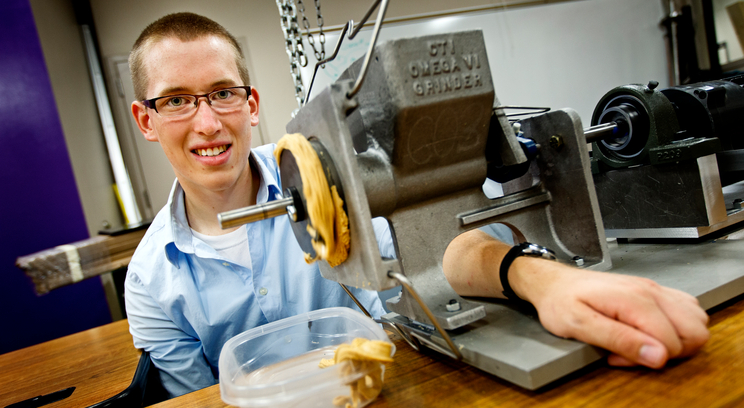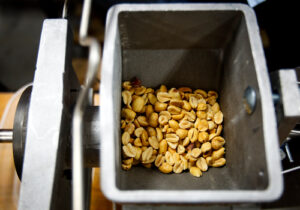Would you believe that the road to food security is paved with ... peanut butter?
It’s one of the ways, and we’re not talking partially hydrogenated Skippy-brand peanut butter. Just ask Dr. Jim Ellingson, assistant professor in St. Thomas' School of Engineering, and junior mechanical engineering major Noel Naughton.
The pair spent their summer vacation grinding 25 pounds of roasted, unsalted peanuts for a study that will help local nonprofit Compatibility Technology International (you might remember them from Friday's Newsroom story "Dr. Camille George and the Future of Breadfruit"), pave this road. The organization creates a range of "practical food and water tools that empower the global poor to better feed and support themselves."
Ellingson, who has attended technology meetings at St. Paul-based CTI for two-and-a-half years, jumped on the opportunity to help the organization determine baseline data for one of those tools, the Ewing IV grinder: a hand-cranked burr mill used throughout Africa and Asia to grind everything from peppercorns into pepper, millet into flour and, in Ellingson and Naughton's case, peanuts into smooth, creamy paste.
CTI, which makes three models of grinders, notes their achievements on its website: "CTI’s grinders have enabled women to start business selling high-value ground products in the market, they help kids pay for school fees, and they're even used to bring back severely malnourished children from the brink of starvation."
Ellingson echoed the nonprofit’s vision for its grinders: "The biggest impact we can make in Africa is with peanuts, or 'groundnuts' as they're known there.”
As a highly nutrition-packed food source, groundnuts thrive in many areas of Africa. The Omega VI, the CTI model he and Naughton used in their research because it allowed for a motor attachment, also is used in homes in Africa where it is human-powered. Generally, one family owns one mill.
Ellingson explained that "our goal was simple − to provide a baseline for the grinder's efficiency. CTI already has shipped hundreds of its grinders to African families, and with great success. But they didn't have baseline data. We're not suggesting design changes. We're providing guidelines and expectations for the device's output."
To this, Naughton added, "the best way to reduce hunger is to give farmers the ability to grow their own food, and our data will provide some scientific evidence for how the grinder is used best."
Ellingson said that "CTI is not interested in chunky peanut butter. So we're studying the power required to make fine peanut butter, which naturally requires more effort."
Specifically, their data measured: 1) the grinder's output, or how many grams of peanut butter the Omega produces per minute based on 2) the torque - which is equal to the amount of force produced at any given distance - in this case, the distance equalled the length of the crank used to turn the steel grinding plates of the mill; and 3) the quality, or fineness (viscosity), of the peanut butter produced.
The reason the fineness measurement is vitally important, he said, is because "peanut butter is their daily bread. It's not something they spread on their daily bread, so it has to taste good. The thicker stuff doesn't lend itself to palatability."
So what did they discover? "Really good peanut butter," according to Ellingson, "has a particle size of 3/1000 of an inch - the consistency of a strand of hair" or, dare we say it, Skippy. For a person grinding nuts by hand, they determined that the typical person (in Africa, typically the grinder is the female head of the household) would need to generate 10 pounds of force at the end of a one-foot crank (the typical crank-length in African homes) at a speed of 60 revolutions per minute to produce an output of 1/2 of a pound of fine-quality peanut butter per minute. A comfortable, reasonable limit, Ellingson said, is "10 pounds of force or less for someone who does this type of work daily."
To arrive at these numbers, they had to standardize and simplify their study so that the traditionally hand-cranked grinder would turn at a consistent speed that mimicked the pace of a human (0-120 rpms). A scale positioned at the end of the crank would give a direct readout of the force required to turn. To that purpose, Naughton spent half of the summer designing a system that would allow him to mount the grinder to a motor, then he built it to those specifications.
Ellingson explained that "our apparatus allows for the quantitative measurement of the effort required for a given task. Where these grinders will be used, human power is much more readily available than electric power and much cheaper, so it is the first choice."
They used a simple and expensive instrument called a Hegman gauge to measure the fineness of their output (peanut butter).
CTI's statement underscores the significant impact of Ellingson and Naughton's study: "Women and girls living in the developing world spend most of their day farming and preparing food for their families by hand. They work for hours grinding their crops with rudimentary, inefficient hand tools like mortar and pestles or stones."
Behind the, at times, complex science of their data collection lies a simple, humanitarian goal: to reduce the amount toil undertaken by people in developing nations to produce their family's daily sustenance. Naughton said, "Once you give them this initial investment, they can take charge of their own livelihoods."
And it was for this cause that Ellingson wanted to take part in this research: "Partnering with CTI is a good fit for St. Thomas. As an engineering department and a service university, what greater calling is there than to feed the world?"










